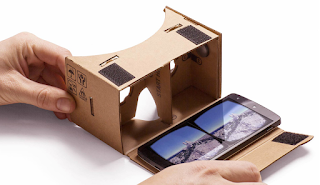Virtual reality (VR) is beginning to gain traction as a viable classroom learning tool. Google Cardboard, the affordable VR viewer, is leading this new area of experiential learning.
Google Cardboard is the 20% project of Google Engineers David Coz and Damien Henry first announce at Google I/O in 2014.
Key Features of Google Cardboard:
- Made from cardboard
- Fits any cell phone
- Works with any VR content
- Cheap ($5-20)
How Does it Work?
What do you Need?
To experience virtual reality you will need three things:
1. A compatible mobile device
Most mid-grade and higher cell phones support VR content. The iPhone, Nexus, and Galaxy devices are all VR compatible. Phones must have an accelerometer and gyroscope in order to work correctly in VR mode. Most inexpensive track phones ($100 or less) will NOT work.
Tablets (iPad and Android) can be used to view VR content in “normal” mode. The experience is not as immersive as using a VR viewer, but is a good option to consider if you already have access to tablets.
Google has partnered with Best Buy to offer a complete classroom VR set which includes everything that you need to experience VR in the classroom. Learn more: http://goo.gl/JP92ts
2. A VR viewer
While you can view VR content without a viewer, the experience is greatly improved when viewed through a compatible cardboard viewer. There are many to chose from:
Cardboard Viewers - Google developed the first viewer “Google Cardboard” and made the construction plans open to anyone. There are thousands of companies offering cardboard viewers. You can even make your own! These viewers are the most affordable ($5-20) but won’t last forever and may not be the best for daily class use.
- Make your own cardboard viewer: http://goo.gl/8ggqYs
- Google Cardboard on Amazon: https://goo.gl/NDePRJ
Plastic VR Viewers - Several companies have started to make more durable plastic viewers. These are optimal for the classroom as they will withstand the wear-and-tear of student use and can be easily cleaned. Viewmaster makes one of the leading viewers which is a great classroom option.
- Viewmaster: http://goo.gl/BEwcCv
3. A VR App
In order to experience virtual reality, you will need access to some virtual reality content! There is a rapidly growing list of content creators who are supporting the VR platform. One way to explore is to simply visit your app store (Apple or Android) and search for “VR” or “Virtual Reality”.
If you are using and app and you see the cardboard icon, that app supports virtual reality. Click the icon to switch into VR mode. Here are a few more popular websites that support VR content.
- YouTube - using a laptop, perform a search and click the “filter” button. Select 360° video.
- Facebook - Facebook is heavily promoting 360° video. Join their group to experience 360° video as it develops: https://goo.gl/WiKE0S
- ThingLink - create your own VR content with ThingLink! Create immersive experiences for your students using the VR editor. Note: requires a ThingLink subscription. Learn more: http://demo.thinglink.com/vr-edu
Google Expeditions
Virtual Reality is an individual experience. This makes it difficult to facilitate a whole-class experience. That is why Google developed Expeditions, a whole-class VR experience.
Think of Google Expeditions as a 21st century version of the Magic School Bus!
Teachers select from one of over 50 virtual field trips and launch the experience using the Expeditions App for Android and iOS. Students will be taken into a virtual world which is narrated and guided by their teacher. Expeditions can be paused to facilitate whole-class discussion and teachers can “point” to any object on the screen to easily guide students.
Google Expeditions is free for schools. Learn more here: https://goo.gl/FPLLCZ







Hey Andy! You aren't the first person to question the value of the Best Buy VR kit. Seems a bit steep.
ReplyDeleteI have tried several low-cost android phones and have yet to find one that has the necessary hardware to run VR effectively. The key seems to be the accelerometer and gyroscope. Most of the low-end phones don't have both sensors.
Jonathan WYlie put together a nice post on assembling your own VR kit using iPod touch devices. According to his research you could put together a set of 30 for less than $7k (as opposed to the $10k Best Buy kit). Here's his post: https://goo.gl/zT9hvu